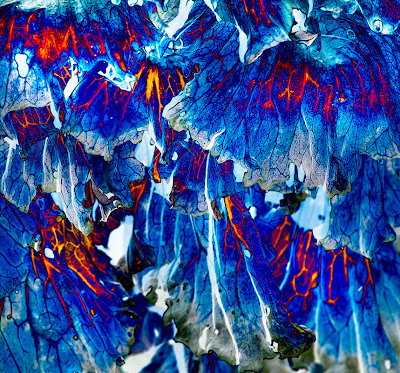
So what happens if you bring an image into Photoshop and manipulate it beyond reason, but like the result. It isn't really a photograph, so what do you call it, do with it, and do you call it art?
The photograph is of frost damaged ornamental cabbage, I happened to like the pattern, and while adjusting the curves, started doing odd things with sinusoidal waves type curves.



8 comments:
I'd say it is as legitimate as you allow it to be.
Maybe it's not a photograph in the strictest definition anymore, but it is still a work of art. Good, bad, like or dislike is a different discussion.
I hate when people are telling you are not allowed to do this or that just because the result is unfamiliar.
I haven't done something like this myself, and it's not too much of it I actually like, but I like the idea that someone is experimenting with weird stuff to find aesthetics we haven't seen before.
Ansel Adams said, "The negative is comparable to the composer's score and the print to its performance.” The extent of the manipulations you have done to your negative are no greater than those Ansel did to make an afternoon sky, black, and the white crosses stand out, in “Moonrise, Hernandez”. No one would say that Ansel’s work is not legitimate.
Photoshop is just another tool in our bag to help us better interpret our negatives/ digital captures.
George, Your image is certainly legitimate art. The confusion commes from the fact that a lot of people are still conceptually stuck at the level of forensic documentation photographs. Unlike in the universe of painting, there are few photographic "genres". Most categories of photographs are defined by their subjet: landscape, nature, portrait, still life, etc. I have no doubt there will eventually be acknowledged photographic categories to fit your cabbage, perhaps it's time to start a group of Photographic Impressionists to accomodate your cabbages.
Jean-Michel Paris
I don't think "legitimate" is the issue. As soon as you start this type of manipulation you are venturing into an entirely new sphere of creativity. The only question is does it work as an image?
Personally I have difficulty with images that result from the crudest and simplest use of Photoshop, especially when applied to a recognisable image. Simply moving sliders to create a weird colour effect leaves me cold.
I like the idea that there has been skillful use of the software to produce an interesting image with aesthetic value.
Perhaps there should be a fourth part to George's series at LL to help develop ways of evaluating this type of work.
Sorry about the deletion - my comment was;
Is it any different than cross-processed film? Or how about film balanced for the opposite of the light the subject is in?
Or for that matter shooting infrared colour or strong filtering. Sounds like most of us agree that the journey isn't as important as the result. On the whole I think this is simply something that's fun to do.
Funny, no one ever critisized Richard Avedon for making wild colorized images of the Beatles with colors similar to these. There is no question in my mind that this is photography and art. You had a vision, you used a camera, you used a technique to cause an effect that you liked, and personally I rather like it. Get crazy George!
Post a Comment